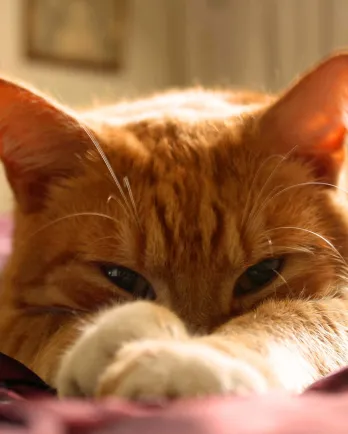How to Modify Your Home for an Elderly Pet
This article originally appeared on Redfin and has been republished with their permission.
How to Modify Your Home for an Elderly Pet
Our dogs and cats are not just pets, but family members. As they age, of course, they need more support from us. Just as people benefit from simple home modifications that offset aging, so do our furry family members.
Redfin, a customer-first real estate brokerage, put their real estate and pet experts together to discuss the best ways to modify your home for an elderly pet.
First, How Old is ‘Old’?
Generally, a cat or dog is considered elderly when they reach six or seven years of age. For dogs, however, size factors into age because larger dogs have shorter life spans. Cats tend to have longer lifespans than dogs, so depending upon weight and breed, some cats may not be considered elderly until they reach 10 or 11 years of age.
11 Ways you can Modify Your Home
1. Raise their food and water
As your pet ages, it may become more difficult for them to lower their neck to eat food or drink water. Invest in a raised platform or use something around the house, such as a shoebox, to elevate the food and water bowls your animal already uses.
Food bowls for cats should be placed away from cat flaps, glass windows that reach the floor, and their litter boxes. They should also be placed in a location where your cat can approach from any direction and not be forced to have their back exposed to other animals in the household.
2. Upgrade the Litterbox
For older cats, arthritis and shrinking kidneys contribute to issues using their litter boxes. There are litter boxes on the market with lower openings designed for older cats, but you can also use a storage bin with an entry way cut out in the front. If you have multiple cats in your household, you should have one litter box for each cat, plus an extra.
3. Buy or Build a Ramp
Arthritis is a common problem in dogs as well. An easy home modification to enable easier mobility for your dog or cat companion is to buy or build a ramp or shallow stairs. A ramp or stairs allows your animal the same freedom and access to couches, windowsills, beds and cars that they had when they were younger.
4. Enhance your Staircase
An easy modification you can make to your stairs is to install anti-slip treads made from carpet or rubber. If your pet can no longer make it up the stairs at all, place their bed in a warm spot downstairs so that they have no need to be anywhere other than the first floor of your home.
5. Prep your Floor
If you can alter the flooring of your home, try installing ceramic tile or carpet tiles designed for pet incontinence. Avoid carpet, because it is more difficult to clean deeply, and natural stone tile,as it stains easily. If you are unable to alter your flooring or have hard floors that are easy to clean, invest in non-slip rugs, carpet runners, or even yoga mats for better traction for your pet. Seek out materials that are easy to wash and do not absorb stains and odors quickly.
6. Try a Doggie Door
Another home modification for urinary incontinence is a doggy door or dog flap. These can provide the freedom for your canine to urinate outside as they need. You will want to install the door in a low area to provide ease of access for any mobility issues.
7. Buy an orthopedic bed
If your dog displays any the behavioral symptoms of joint problems, an orthopedic bed is specifically designed for their needs. Smaller dogs should sleep in a bed relative to their size because they get cold more easily and may feel insecure in a larger bed. If you have a dog flap installed, place the dog bed near the door for easy access to the bathroom.
If your pet is an older cat, place their bed within the vicinity of their litter box, but not too close to it. Cats also enjoy cave-style beds just like their ancestors.
8. Double check your temperature
Older animals have more difficulty regulating their body temperature, so they are more sensitive to temperatures that varies significantly from their own body temperature. Set your thermostat between 78 and 80 degrees and pay attention to your animal’s specific behavior. If they hang out by a fan or the heater, they may need an adjustment outside of the 78- to 80-degree range.
9. Create a routine
Dogs are creatures of habit, so keeping their routine consistent will help mitigate anxiety. This goes for cats as well. As cats age, anxiety can be caused by disorientation and confusion, so a regular daily routine and consistent placement of your cat’s litter box, bed, and food is important.
10. Reduce Stress with Sound
Increased sensitivity to sound is stressful for older animals as well. Keep a white noise machine or background music playing in your home to prevent this source of stress.
11. Create a Play Space
Have a play corner in your home where you keep all of your cat or dog’s toys and be sure to regularly engage with them here. Regular play time in old age can keep your pet physically stimulated as well as mentally, fighting against anxiety and cognitive decline.
You Can Improve Quality of Life
These home modifications can improve your animal companion’s entire quality of life and increase their lifespan.
Even though they are only one part of our lives, they improve our relationships, stress levels and mood, as well as our cholesterol and triglyceride levels. Our pets deserve to live out their lives with security, comfort and love.
See the original article by Redfin.



